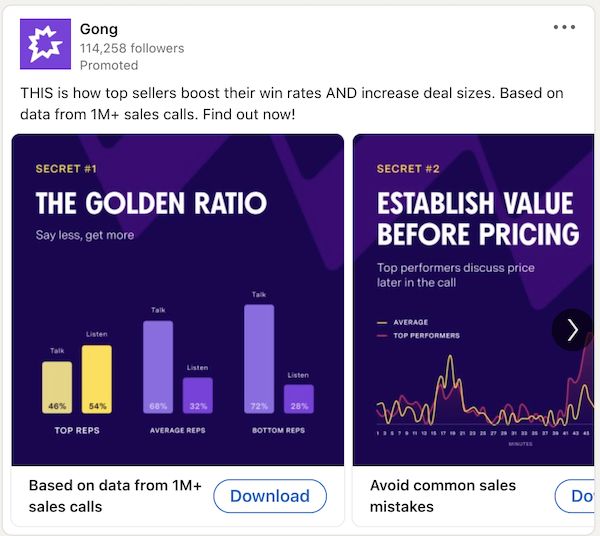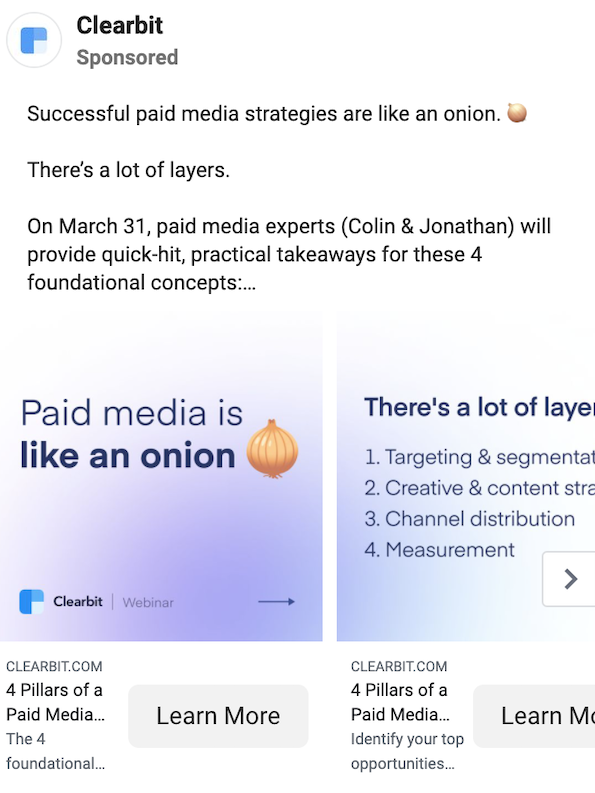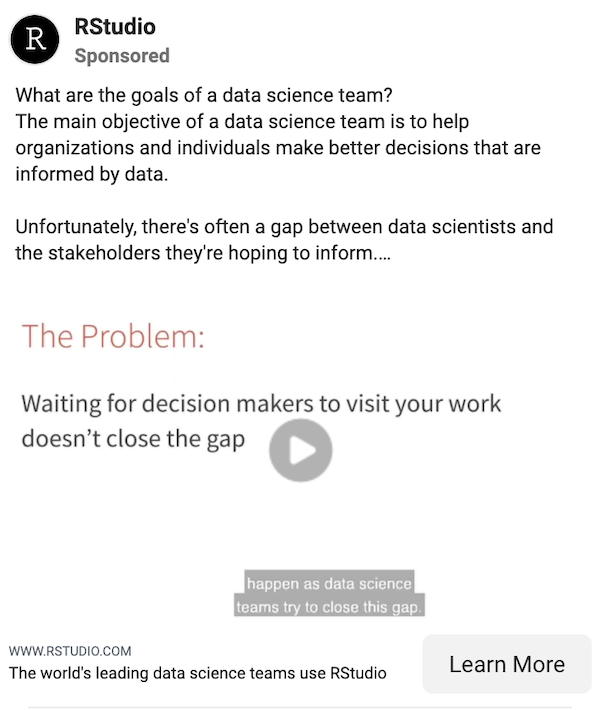4 ways to improve ad creative for more effective B2B campaigns
Today, ad creative carries more weight than they ever have.
Advertising is more expensive – especially on Facebook, where CPMs rose 33% in the first two years of the pandemic — so creatives need to perform well to make up for it. To make matters worse, people are less likely to click on ads, due to changes in the way B2B buyers research products compared to ten or even five years ago.
Since more and more people will never see what comes after the click, what’s on your ad before the click is pretty important.
We’ll share a few ways to design creatives that perform better for buyers’ new research behaviors and preferences.
What’s different about the way people interact with B2B ads today?
You may have noticed the following changes in your prospects – and maybe yourself – over the last few years.
Reluctance to share personal information and be a “known prospect”
- People increasingly prefer to remain anonymous while they research products.
- People are wary of their privacy and don’t want to fill out long lead forms with their mobile number, as was customary in the recent past.
An exodus to dark social, where people are tough to track and target
- B2B buyers want to learn about a product’s pricing and packaging from peers before becoming a “known user” to the company (via a form fill or free trial, for example).
- They are increasingly learning about products from peers on dark social, which includes difficult-to-track platforms like Discord, Slack, Reddit, and YouTube, as well as one-on-one conversations like texting, email, and DMing on LinkedIn. Certain buyers are shifting away from Facebook and Instagram to be more active on these channels.
Less clicking, more scrolling and lurking on social media
- Engagement on traditional social media platforms is trending down. People scroll and lurk more than they used to, and they post, click, and share less.
- People are reluctant to click on ads, wary of being virtually “followed around” or “listened to.”
Contrast this to older buying behaviors, when people learned about products through gated content, analyst reports, and tradeshows. There were also fewer online privacy regulations and fewer competitors.
So today, every ad impression counts more. It’s time to change the way you design ads and front-load as much value as possible into the ads themselves, so that they pack a punch and remain a cost-efficient way to acquire customers in a less engaged online world.
1. Design ads for people who scroll — but don’t click
Today, carousels, videos, and GIFs provide a lot of real estate to offer value right in an ad itself, “no click required.” A scroller should get value from an ad just by looking at it.
Jonathan Bland, cofounder of demand agency Omni Lab, points out that a lot of content is just a product brochure in disguise. An ad that says “Download our ebook” asks your prospect to click on the ad, fill out a form, and dig through a PDF to find value.
“Over 99% of people who see your ad will never click on it,” Jonathan says. So optimize for the 99%.
Here’s a great example from Gong. Instead of an ad that says “download our ebook,” it pulls a few real takeaways out of the ebook and displays them in a carousel.

The slides are titled Secret #1 and Secret #2, and each one has an attention-grabbing statistic from Gong’s research.
Here’s an example of a carousel Clearbit made to promote a webinar. We teased slides and information — the emphasis is not on the webinar, but on the insights.

RStudio, which creates solutions for data scientists, significantly expanded their reach for awareness ad campaigns by advertising on Facebook and Instagram — while dropping their ad spend up to 20x for qualified leads compared to LinkedIn. Ad design contributes to RStudio’s ability to spread their message in a cost-effective way.
Robert Bethell, RStudio’s Head of Demand Generation, says, "The best part is they don't even have to click on the ad unit. Just to be able to get the messaging in front of these folks is worth it when you measure out the spend and gain."
RStudio’s ads are immediately engaging and educational, using both text and video.

Bottom line? Optimize ads for consumption, not clicks. Use ads to tell a story in the viewer’s feed.
Even though people are clicking less often, you’ll have plenty of ways to make an impression.
2. Invest in creative and do things that stand out
As you optimize ads for consumption instead of clicks, good creative pays off more, because your message can still engage the 99% who won’t click.
Colin White, Clearbit’s Director of Demand, explains that these days your offer absolutely needs to be interesting and engaging, or no one will care. “I'm always surprised by the fact that people will spend tens of thousands of dollars pushing an ad on a platform, but they won’t spend any money on creative,” Colin says. “Spend a little bit of money on design and it's going to go a long way.”
Sidney Waterfall, General Manager at Refine Labs, advises her clients to get their core ads running and then keep testing new things, always pushing the boundaries. “Do fun stuff that stands out in the feed,” she says. “Get creative with offers and use punchy copy.”
“You’ll be really surprised at what might work. Raw, direct creative works best for some brands, and for other brands and audiences, it doesn’t work at all. Experiment with things you’ve never seen before, or try consumer ad trends. You have to push it.”
Because if you’re going to put dollars behind an ad, it needs to be good.
3. Answer questions, problems, and jobs to be done for different ICP segments
Getting more targeted with your creatives has a huge payoff in terms of how compelling the ad creative will be. Most companies go too broad with their targeting, Jonathan Bland says.
You should not only define an ICP but also define multiple segments within that ICP, so that you can get even more targeted and make different creatives for each one. Ad creative should answer specific questions, problems, and jobs to be done for each sub-segment of your ICP.
For example, if your company sells a slightly different product to sales teams and marketing teams, “sales” and “marketing” are two different segments.
Then, you can further split these segments into decision maker personas versus user personas (because users are not buyers).
In Clearbit’s Data Activation Platform, you can define these sub-segments with data attributes such as:
- Employment Seniority, where the higher-level titles like “Director” or “Executive” are more likely to be decision makers
- Employment Role, where you can specify a department like “Marketing” or “Sales” to differentiate between segments — or even to target decision makers in other departments (such as “Finance”)
The next step is to figure out which channels each of these ICP segments spend time on — Facebook, LinkedIn, Reddit, etc. — so that you can design your creatives to fit the format and the culture of those channels.
You might find, for example, that your “developers” segment is most active on Slack and Reddit, while your “sales ops” segment is most active on LinkedIn and Facebook. Simply spend time in various channels to see whether people in your segments are active and what they’re talking about.
Once you know who to target and where to target them, you can figure out their problems — and try to answer them in your ad.
4. Use a content matrix to find ad topics that resonate
To figure out your buyers’ questions, problems, and jobs to be done, try using a content matrix.
A content matrix holds ICP segments in the left column and guides you to brainstorm content topics for each one. Here’s a simple example.
Can you start to answer these questions in an ad without making people click on it?
Ads that work better for new B2B buyer behaviors
Because of the new ways people browse and buy B2B products, your old ad creative may underperform.
Boost your performance by giving your prospects something to smile about in the ad itself, instead of after the click — information that’s interesting and helpful to their jobs. Use a content matrix to figure out the problems and questions they’re struggling with.
And then experiment with ways to get that information across. Push the boundaries. Always make sure that a portion of your budget is going toward testing something new, and put more budget toward developing creatives in general. When every ad impression is more expensive than it used to be, investing in creative pays off.

